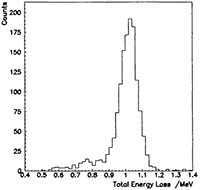EPHIN - calibration

- Figure 1: Mass separation of p, d, t, and 3He, 4He achieved at HMI/Berlin cyclotron with 120 MeV 4He primary beam on Au-target. A minor population of 6He, 6Li, and 7Li can be identified. right: Mass separation z2m resolved via projection of HMI results along theoretical energy-loss curves
The semiconductor detectors A-F have been calibrated individually using an 241Am source resulting an a single-point calibration of the detector/electronics system and the onboard data analysis.
The scintillator-photomultiplier combination of the anticoincidence detector G has been calibrated in terms of photoelectron production for minimum-ionising particles using a 207Bi source and cosmic-ray muons. Due to the shape of the detector, the light collection is position dependent. Worst case analysis shows a signal well above detection threshold.
Cosmic-ray muons and air shower electrons have been used to gather information about long-term variations of the detector performance while the instrument is still on ground. Instrument resolution for cosmic-ray muons is 18 keV in detectors An, 25 keV in Bn, 200 keV in C, 340 keV in D and E (FWHM).

- Figure 2: Classification of electrons as number of coincidence counts normalized to total number of detected coincidences measured at INW/Gent (left) and via Monte-Carlo simulation (right).
The EPHIN calibration with hydrogen and helium nuclei was done with the facilities and support of the Hahn-Meitner-Institut in Berlin, Germany. The desired low energies (4-120 MeV) and low intensities (~100 cps) were realized by using the reaction products from the interaction of the primary 120 MeV 4He beam with a gold target. By means of a magnet spectrometer and a small slit in the focal plane it was possible to select particles of a certain magnetic rigidity with an energy resolution of better than 0.5%. The instrument was positioned in the vacuum chamber as close as possible to the slit, while still leaving enough space for linear and angular displacement of the sensor. Fig. 1 demonstrates the seperation of the different nuclei for absorbed particles.

- Figure 3: Energy resolution of 1 MeV electrons stopping in detector C as sum of signals of detectors A, B, and C.
The calibration with electrons was done with the facilities and support of the Nuclear Physics Laboratory INW in Gent, Belgium. Over the full energy range (0.2-14 MeV) the dark current of the linear accelerator produced sufficient intensities. The energy selection was done using an aluminium target and focussing magnets with collimators resulting in an energy resolution of better than 100 keV. The measurements were carried out in vacuum.
The relative efficiencies of the different electron channels compared to the result of a Monte-Carlo simulation of the instrument are showm in Fig. 2. The energy resolution of 1 MeV electrons (as an example) stopping in detector C is shown in Fig. 3.
More information about EPHIN
The EPHIN pages are based upon
R. Müller-Mellin et. al.
COSTEP - Comprehensive Suprathermal And Energetic Particle Analyser
Solar Physics 162: 483-504, 1995

